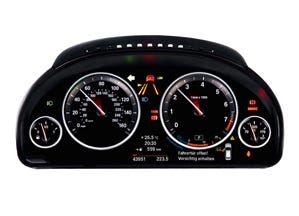Negative-formed instrument cluster a highlight for Johnson Controls
Frankfurt—In what the Tier One supplier says is a world novelty, it is thermoforming 3D instrument cluster panels for BMW using a black sheet it developed that allows warning lights and other displays to brightly shine through it, with no sign of distortion and no need for a secondary anti-reflective coating. The parts also show no sign of polarization at their sharp edges.
September 16, 2009
Frankfurt—In what the Tier One supplier says is a world novelty, it is thermoforming 3D instrument cluster panels for BMW using a black sheet it developed that allows warning lights and other displays to brightly shine through it, with no sign of distortion and no need for a secondary anti-reflective coating. The parts also show no sign of polarization at their sharp edges.
|
Patrick Nebout, director of product management and strategic planning for Johnson Controls' Global Driver Information unit, told MPW that the panels are negatively thermoformed. By placing the film face down in the tool, the texture of the tool gives the film's surface an embossed structure that eliminates the need to add an anti-reflective coating to the surface of the cluster, he said Tuesday during an interview at the IAA automotive show in Frankfurt. The result, displayed at its IAA stand this week, is an instrument cluster with much sharper resolution.
He also said the company has optimized its thermoforming so as to reduce the reflection/interference known as Newton’s rings at the sharp thermoformed edges between the flat printed analog speedometer and tachometer, and the surrounding digital information display.
The company showed off a broad range of instrument clusters, most of them drawing attention to the individual 'looks' it can achieve on injection molded decorative rings that could be added to, for example, the speedometer to give it a carbon fiber-printed surface appearance or a chrome appearance. "This lets our customers differentiate their brands without a big investment," explained Nebout.
Also on display were some prototypes of revealing how the instrument cluster of the future might appear, with a TFT (thin-film transistor) display integrated into the speedometer and tachometer so that there a driver would see not only speed or RPMs but also entertainment system information, navigational advice, or more. —Matt Defosse
About the Author(s)
You May Also Like



